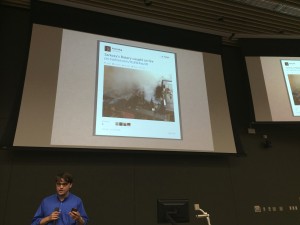After checking in, making it through the routine information session and quickly being introduced to classmates and instructors, MIPA participants gained insight into how vital smartphones are in the rapidly changing field of journalism.
Fritz Klug, a multimedia journalist for MLive, explained that with just one pocket-sized device reporters have all of the tools they need to formulate a story on the spot. The built in camera, voice recorder, notepad and video camera also give the correspondent more options when it comes to how they want to present the material. Not only is the technology versatile, but smartphones are efficient.
“The smartphone is the first device that allows you to collect, capture and edit information into a story that people can digest and then publish it at the same time,” Klug said. “Before you would have needed a dozen people to do what I can do with this smartphone.”
When it comes to releasing the story, journalists also have more options. Photos can be used for more visual stories, videos can capture specific moments and other stories or references can be linked to full stories for more information. The possibilities are endless, and with new apps constantly being created, it is becoming simpler by the day to report from any location.
Despite the ease of physically uploading material to the web, Klug believes that journalism is still a very important and serious profession. Any person can pick up a phone and post something on Twitter, but it comes down to the information they are providing and the ethics with which they have obtained that information.
“The person using the machine still needs to be a journalist,” Klug said. “Journalists have to ask all the tough questions and provide people with a complete story. They tell people why and what impact [an event] has and if we should be concerned or be bystanders in the situation.”
Klug also explained that using social media is another outlet that can be beneficial for breaking news and reaching a large amount of people in a short period of time. With so many people using smartphones, sites like Twitter, Facebook and Instagram make spreading information simple and accessible to a wide audience.
“On Twitter I follow different news sources and when a story catches my eye I’ll read it,” H.H. Dow High School sophomore Maggie Schaller said. “I also have a variety of news and entertainment apps that I check regularly, but I rarely pick up a print newspaper.”
While new advances in smartphone technology have changed the ways journalists tackle stories, Klug stressed that reporters should not become too reliant on their technology. He stressed over the course of the presentation to use apps that can easily be backed up and keep track of the important information from interviews and events covered in multiple places.
“There have been too many times where I wish I would have just brought along a notepad to write down what people are saying,” Klug said. “If someone has a great quote, don’t rely on your voice recorder. Write it down. You need backup ways to keep track of your information because technology fails. There is a balance between when to use your phone and when not to use it.”
Students responded well to the lecture and found the techniques Klug shared to be both innovative and useful as teenagers. They are looking forward to implementing them for their student publications back home and to expand on their journalistic skills wherever they find themselves.
“I think [the presentation] showed us creative, new ways to approach journalism and showed us that we can take news anywhere we go,” Traverse City East Middle School eighth grade student Kaitlyn Argue said.
To read Klug’s “Five things to remember when doing journalism with your smartphone” and see some of his favorite apps to use for reporting, visit Fritz’s website.


[…] MLive journalist Fritz Klug speaks about the power of smartphone journalism […]